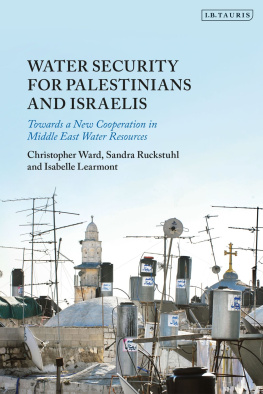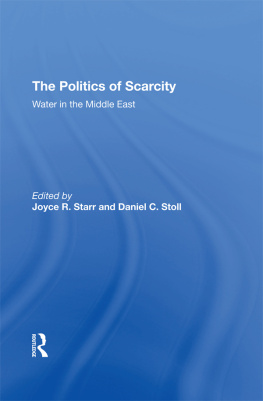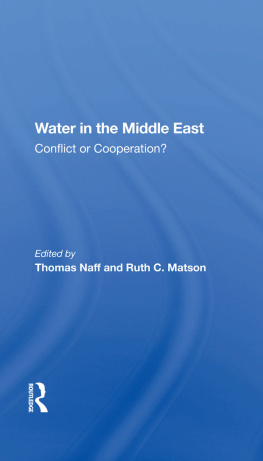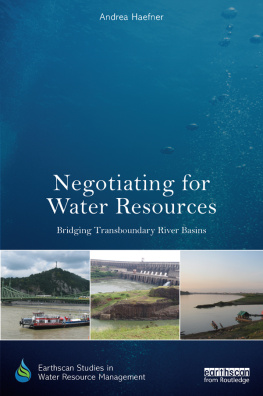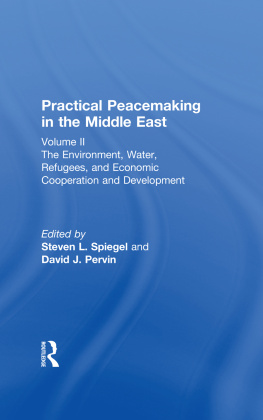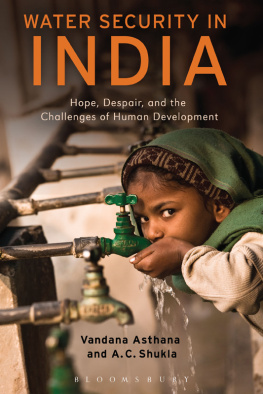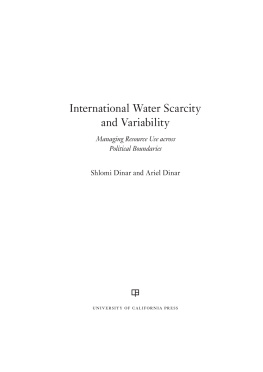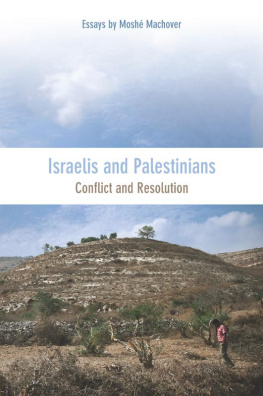Water Security for Palestinians and Israelis
Dedicated to the memory of our late teachers Tony Allan, Albert Hourani, Roger Owen, Robert Mabro, Donald Russell, Adrian Sherwin-White, Freddie Beeston and Dennis Sandole
And in love and gratitude to our friend and guide, the late William St Clair, scholar and mentor to so many
Water Security for Palestinians and Israelis
Towards a New Cooperation in Middle East Water Resources
Christopher Ward
Sandra Ruckstuhl
Isabelle Learmont
Contents
Part I
WATER SECURITY FOR ISRAELIS
Part II
WATER (IN)SECURITY FOR PALESTINIANS
Part III
TOWARDS A NEW COOPERATION ON WATER SECURITY FOR ISRAELIS AND PALESTINIANS
Figures
Elements of Water Security |
Global cumulative installed contracted and commissioned desalination capacity, 19652015 |
The Ashkelon desalination plant, with permission from IDE Israel |
The Shafidan Dan Region Central Sewage Plant, Photograph by courtesy of Igudan |
Shafidan soil aquifer treatment method, Israel |
Israels water resource development, 19582014 |
Israels hi-tech agriculture: hothouses at Ein Yahav, Wikimedia Commons |
The River Jordan as a dirty drain, with permission from Faith-Notre Dame |
Breakdown of water sources in Israel, 1985, 1995, 2005, 2014 |
Israeli water tanks, Palestinian water bowsers in the West Bank, with permission from Irish Central |
Average daily per capita water delivered to all consumers, West Bank, 2015 |
Water and sewerage deductions by Israel, 200816 |
Proposed restructuring of water and sanitation service provision |
Percentage of population with access to safe drinking water in the Middle East and North Africa |
Israeli water tanks in Hebron, the West Bank, with permission from Irish Central |
Palestinian water tanks in Hebron vandalized by Israeli settlers, Wikimedia Commons |
Swimming pool at the Israeli West Bank settlement of Maale Adumim, Davidmosberg on Wikimedia Commons |
Comparing Reuse of Treated Wastewater and Percentage of Wastewater That Undergoes Treatment |
West Bank Olive Harvest, Wikimedia Commons |
Traditional West Bank Irrigation Canal, with permission from Nora Stel |
Restrictions on storage impede irrigation: Israeli soldiers watch as machinery destroys a Palestinian cistern, with permission from Palestine Portal |
Agricultural Water Productivity |
Annual discharge of springs, 200411 |
Palestinian boy drinking from tanker, Image courtesy of IMEMC |
Settler agriculture in the Jordan Valley, with permission from Kiva |
Palestinian crops in the Jordan Valley destroyed by Israeli army, with permission from Amnesty International |
Palestinian farmer arrested for water theft, Photograph by courtesy of +972 |
Children fetching water from a temporary tank in the Gaza Strip, with the ruins of the Khuzaa water tower in the background, Photograph by courtesy of CMWU |
Tables
Major Seawater Desalination Plants in Israel |
Wastewater treatment in Israel (2015) |
West Bank: Allocation of Water Resources of the Three Shared Aquifers |
Abstractions from the Three Shared Aquifers within West Bank and Israel 1999 |
Palestinian Abstractions from the Three Shared Aquifers 1999 and 2007 |
Sources and Uses of Water for Palestinians in the West Bank, 2013 |
Annual Available Water Quantity in Palestinian Territories by Source, 2017 |
Domestic Water Supply and Demand for Palestinians in the West Bank, 2016 |
Sector Targets According to the 2016 SDP: West Bank |
Water Service Key Performance Indicators for the West Bank (KPIs), 2014 |
Efficiency and Financial Viability Key Performance Indicators (KPIs) for the West Bank, 2014 |
Water Sector Strategic Development Plan (SDP): Water Supply Targets |
Guiding Principles for Water Sector Reform |
Proposed Treatment Standards |
Water Sector Strategic Development Plan 201722 (SDP): Targets for Sanitation and Wastewater in the West Bank |
Small-scale On-site Wastewater Treatment Projects Implemented in the West Bank |
Rainfed and Irrigated Areas in the West Bank |
Estimated Costs to the Palestinian Economy of Foregone Opportunity in Irrigated Agriculture |
The Share of West Bank Natural Resources Located in Area C |
Total Water Availability in the Gaza Strip in 2014 |
Water Service Key Performance Indicators for the Gaza Strip (KPIs), 2014 |
Efficiency and Financial Viability Key Performance Indicators for the Gaza Strip (KPIs), 2014 |
Water Resources Investment Plan for Gaza 201722 Development of New Water Resources |
Gaza Sanitation and Wastewater Targets in the SDP 201722 |
Water Resources Available to West Bank Palestinians (2017) |
Water Resources Available to Israel (2016) |
Hypothetical Reallocation of the Annual Potential Yield of the Mountain Aquifers |
Maps
West Bank ABC, UNOCHA
The authors are entirely responsible for the content of this book, but we must mark our great appreciation of the many friends, colleagues and interlocutors who have helped us to understand the challenges or have provided invaluable information.
The very many people in the Palestinian territories and in Israel who helped us are too numerous to mention by name but we would like to extend our thanks to every one of them. We must, however, record our huge thanks to Gidon Bromberg and his colleagues of EcoPeace who have long laboured in the vineyard in which we now trespass. We also acknowledge the generous cooperation of many Palestinian communities, including in Jenin, Falamyeh, Jayyous, Yatta, Aqraba and Farkha, and in Gaza City and Khan Younis.
Several experts have unstintingly supported us in aspects of this endeavour, including Dr Mark Zeitoun, now professor at the University of East Anglia, the late professor Tony Allan, the doyen of Middle East water studies at Kings and SOAS, London, and Dr Shimon Tal, former water commissioner of Israel. We also thank Professor Eugene Rogan of St Antonys College, University of Oxford, and Dr Marc Valri and his colleagues and students at the Institute of Arab and Islamic Studies of the University of Exeter. We also acknowledge the inspiring work of Professor Ilan Papp and of Dr Seth Siegel, both of whom have made dry stories come alive.
Colleagues from the World Bank have over the years been an inspiration and a support, and on the subject of this book in particular we learned much from Salah Darghouth, Sabine Beddies, Pier Francesco Mantovani and Adnan Ghosheh.

